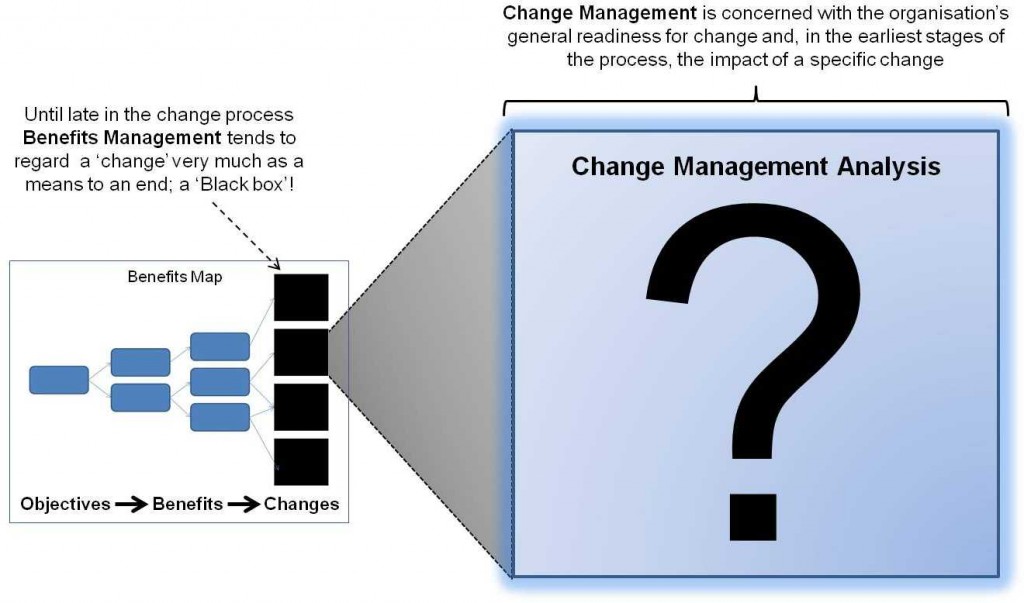To be effective, the Benefits Realisation Management discipline needs must work in concert with an organisation’s Project, Programme, Portfolio and Change Management capabilities; this presentation highlights some key, mutually beneficial and interdependent, aspects common to each.
Category Archives: People Engagement
Working in an organization implementing Benefits Realisation Management?
The most powerful and utilitarian aspect of Benefits Management is that it enables and brings them together in an integrated package; each element reinforcing the worth of the others. Each of the factors detailed below stand up in the in their own right as being advantageous to organisational change:
- everybody has a sense of purpose
- no one can ‘just’ make changes
- people know who is responsible for what change related function
- there is a common approach to the management of change
- change only gets easier as lessons learned are captured and communicated across the organisation
- opportunities that might otherwise be overlooked or perceived as adding little value can be explored and evaluated for their real worth to the organisation; these can and often do come from within the workforce
- changes where the evidence show little or no gain to the organisation can be stopped relieving the pressure on those personnel labouring on difficult or unpopular change projects
- the confidence in the organisation to deliver beneficial change is high
- issues and problems associated with change are ‘surfaced’ and dealt with swiftly
- change is something that the organisation can embrace rather than be anxious about
- individual and functional goals are easier to manage
- people have a platform for greater collaboration
- the greater expectation placed on individuals supports the organisation’s leadership aspirations
- a portfolio of change projects can be established where each is selected based upon its evidential contribution to the organisation’s goals
There are further organisational gains that could be added as direct result of using Benefits Management but they are more related to business performance rather than the experiences of individuals which is the focus of this post.
It must be stressed that Benefits Management enables and supports these desirable outcomes but in order to achieve them significant cultural change must be examined and made. The Benefits Management rigour does though enable the context and agenda for such change to be made.
The role of Change Management
It is evident that Benefits Management has the potential to provide a significant boost to the results of Organisational Change initiatives but there is much to suggest that the increased utilisation of Change Management knowledge and practises would increase those gains further.
However, although recognised as a key management discipline, the role and utility of Change Management is often ‘under-estimated’ and ‘under-exploited’ resulting in unnecessary stakeholder uncertainty and frustration which, in itself, can have a significantly adverse impact on change performance and increase the build up of resistive and regressive forces.
Whereas the Benefits Management discipline tends to treat a specific change as a ‘black-box’ up until its deployment is being considered, Change Management manages the overall organisation’s readiness and preparedness for change and seeks to go ‘inside the box’ to analysis and expose the characteristics and nature of the changes to be made e.g. people, systems, process, behaviour, culture, environment etc at the earliest opportunity in the process.
In raising the profile of Change Management, the role that Benefits Management plays in implicating the organisation’s personnel in the identification and design of the required changes should not be ignored. When combined, the practises and rigour of Benefits Management and the learning and experience of the Change Management discipline do much to enable successful and sustainable change.
Addressing the ‘what’s in it for me?’ factor
In my capacity as a practicing Change Manager I have been looking closely at the subject of Benefits Management. I was drawn to it because it was clear to me that, appropriately managed, this was an approach with enormous potential as a vehicle for achieving effective organizational change. For me, the most striking feature of Benefits Management is the opportunities it presents, across the entire change lifecycle, to engage and implicate personnel from the whole organisation. The approach negates many of the issues surrounding stakeholder management and in particular change resistance, which can be completely mitigated.
However, I feel that to date, Benefits Management, by being promoted in the main by the Project Management fraternity, has not been exploited sufficiently for Change Management worth and utility. In the author’s opinion, organisational Change Management, a management discipline in its own right, must be able to call upon the capabilities of all other related disciplines to contribute to the delivery of its goals; in this case benefits and project management.
By their very nature, projects and programmes are both objective and temporal in nature whilst Change Management with its unique pan-organizational positional influence, is more subjective and, with the interests of the whole organization in its scope, provides for a continuum that personnel, being able to move between projects and programmes, are able to embrace the organization’s Change Management ethos.


